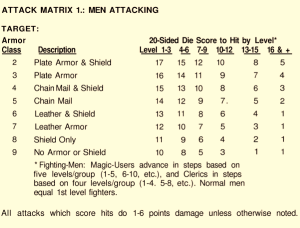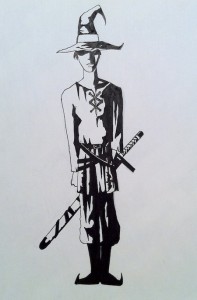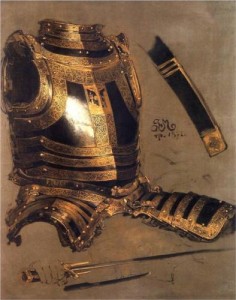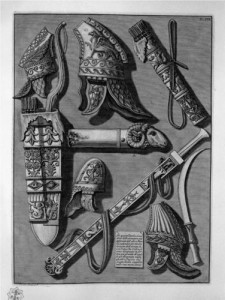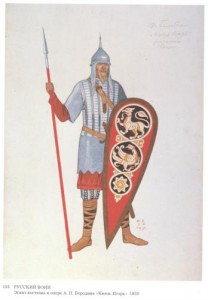Back in June, I discussed potential rules for what happens when magic-users wear armor. I ended up settling on a d6-based individual initiative system, which makes armor increase the chances of spells being disturbed by penalizing initiative. I have been using this for the past three or four months now, and it has worked out well, though we still sometimes forget to enforce the declare spells step. From here on out though: if the initiative die has been thrown, but no spell has been declared, no spell will be cast! This is, of course, true for NPCs as well.
The procedure is as follows.
- Declare any spells
- Each player rolls 1d6 (including the referee)
- Subtract 1 for a dexterity of 13+
- Add armor penalty (see below)
- Referee counts up (so lower is better), and players act in turn
- Armor category: heavy (plate) = 3, medium (chain) = 2, light (leather) = 1
- Armor skill: fighter = 3, cleric = 2, thief = 1, magic-user = 0
- Armor penalty = armor category – armor skill, minimum 0
That is a complicated way of saying that if you are wearing more armor than your class uses normally, you take an initiative penalty equal to the difference.
Magic-users or clerics casting a spell must chant and gesture, and are thus natural targets. If the character is disturbed before the spell resolves, the spell is interrupted, and a saving throw must be made or the spell is lost.
All retainers (or NPCs being controlled by a player) act on that player’s initiative number, and most of the time all hostiles act on the referee’s initiative number (though occasionally the referee may use multiple initiative dice for different groups of NPCs).
Armor penalty also applies to physical ability checks, physical saving throws, thief abilities, and other similar rolls. For example, even outside of combat, a magic-user wearing heavy armor will take a -3 penalty to attack rolls, strength checks, saving throws versus dragon breath, and so forth.
If a thief “wins initiative” (that is, acts before all hostiles), the option to hide in shadows while in melee is available (requiring the standard thief skill check). This allows thieves to then either retreat without chance of pursuit or take actions in future rounds with surprise (including backstabs). Thieves may always attempt to hide in shadows when not in melee.
Any character that has not yet taken a turn and is not casting a spell may attempt to intercept an attack directed at another character, as long as the action makes sense in terms of fictional positioning. Fighters may attempt one intercept per round without sacrificing their standard action. Retainers that have been directed to defend may need to pass a morale check before they will attempt an intercept, depending on the situation. Succeeding in an intercept attempt requires making an attack roll and hitting a better AC than the attacker (this is essentially a contested attack roll).
The formal hide in shadows rule is new. The intercept rule has been active for a while, but is one that we tend to forget about. It is worth remembering though, because it makes fighters and hired bodyguards more useful.

